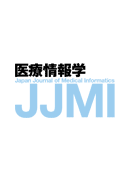
- |<
- <
- 1
- >
- >|
-
T Okui, J Park, N NakashimaArticle type: Proceeding of the Spring Meeting on Medical Informatics
2020 Volume 40 Issue 2 Pages 61-72
Published: October 09, 2020
Released on J-STAGE: October 25, 2021
JOURNAL FREE ACCESSAlthough administrative policies for multi-drug prescriptions of psychotropic drugs have been enforced by the revisions of medical fees, the effects of the policies have not been fully evaluated. In this study, we evaluated whether the trends of the number of patients who were prescribed multiple psychotropic drugs have been changed by the revisions of medical fees using electronic healthcare records data of a University hospital. We used the data of patients who were prescribed a psychotropic drug in Kyushu University Hospital from April 2008 to March 2019. We used GLS and GLARMA as interrupted time series analysis methods. As a result, it was shown that the proportion of patients who were prescribed multiple anti-psychotic drugs or anxiolytics has begun to decrease since the introduction of the policies. As a result of interrupted time series analyses, the estimate of interaction between time and the policy effect was -0.143(95%CI:-0.275, -0.011) for anti-psychotic drugs, and -0.394(95%CI:-0.634, -0.154)for anxiolytics. Therefore, it was shown that the trend of the number of patients who were prescribed multiple drugs has been changed downwardly for anti-psychotic drugs and anxiolytics.
View full abstractDownload PDF (1736K) -
D Shibata, Y Kawazoe, K Shimamoto, E Shinohara, E AramakiArticle type: Proceeding of the Spring Meeting on Medical Informatics
2020 Volume 40 Issue 2 Pages 73-82
Published: October 09, 2020
Released on J-STAGE: October 25, 2021
JOURNAL FREE ACCESS[Background] Pain management and the sharing of information on pain between medical staff and patients, are significant elements in the medical domain. However, information on patients’ pain is generally included as free text in clinical notes, making it difficult to extract the required information from clinical notes. [Purpose] We aimed to extract pain information from clinical notes and to conduct a factuality analysis. [Method] Clinical notes, generated in July 2016, were obtained from the University of Tokyo Hospital. Sentences were denoted with spaces, indents and commas in the notes ; 20,000 sentences were randomly selected for analysis, and medical experts annotated pain-related information in the data. [Result] We obtained an average F1 of score of 56.4 with BERT, which was pre-trained using clinical notes. [Discussion] The experimental result indicates that BERT could improve accuracy in extracting pain information from clinical notes.
View full abstractDownload PDF (1014K) -
R Takano, S Miyamoto, M Ishii, H Ishiura, S Tsuji, K OheArticle type: Proceeding of the Spring Meeting on Medical Informatics
2020 Volume 40 Issue 2 Pages 83-95
Published: October 09, 2020
Released on J-STAGE: October 25, 2021
JOURNAL FREE ACCESSWith the advance of DNA sequencing technology, patient genomic information has been leveraged in daily clinical practice. At the same time, several fundamental issues still remain unresolved, including massive genomic data processing, update, security and quality control as clinical testing. For future precision medicine with patient’s whole-genome information, we particularly focused on the following four practical issues: (1) Management of large-scale genomic data, (2) Validation of pathogenic variants, (3) Assurance of genomic data quality, (4) Consideration for sensitive genomic data. Herein, we prototyped a genomic diagnostic platform with agile methods and then assessed the effect and feasibility of the system architecture, which includes a clinical database optimized for ingesting huge genomic data, user-interface enabling efficient variant filtering and clinical decision support, traceable genomic data management framework and secure reporting storage and viewer linked with a hospital information system that contains personal patient information. In conclusion, the present study has demonstrated that our prototyping platform worked properly and effectively in clinical setting. Even though most components are still in a proof-of-concept stage, some have been introduced in advanced medical service.
View full abstractDownload PDF (2455K)
-
S Irino, E Kimura, H Ishida, Y KuriharaArticle type: Interest Material
2020 Volume 40 Issue 2 Pages 97-105
Published: October 09, 2020
Released on J-STAGE: October 25, 2021
JOURNAL FREE ACCESS【Purpose】 We conducted a nationwide survey of institutions on the provision and use of health checkup data to third parties, before the ‘Next Generation Medical Infrastructure Act’ came into effect in May 2018.【Method】 We selected 298 institutions based on the number of institutions per prefecture and sent a mail survey from July 18 to August 31, 2016.【Results】 There were responses from 79 institutions, of which 46 institutions make secondary use of the personal information. Sixty-three institutions would provide health checkup data to third parties if those were satisfied with the requirements. Those requirements include the validity of the purpose of providing the data, anonymization of the data, and how the information is managed by the third party institution. On the other hand, the policies of the health institutions holding the health data were not so affected even if provided data were processed with highly safe anonymization technology.【Discussion】 The results of this survey suggest the necessity of two improvements in process of health data provision to the outside. One is the manner of the third party institutions. Those must clearly explain the reason why they need the health checkup data and the purposes of the usage of the data and the information management system. Another is to establish anonymization technology that adheres to the guidelines stipulated in the Next Generation Medical Infrastructure Act.
View full abstractDownload PDF (1155K)
- |<
- <
- 1
- >
- >|